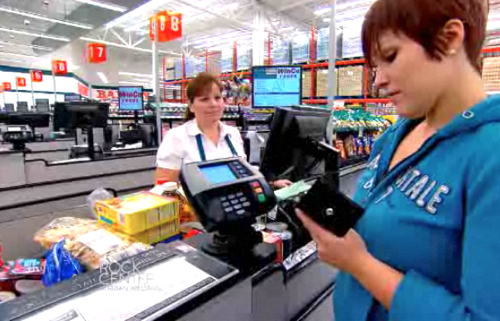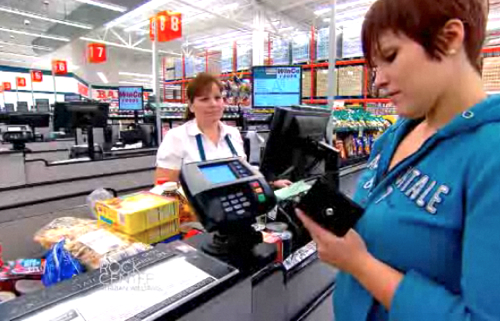 A scene from Rock Center with Brian Williams.Food Studies features the voices of volunteer student bloggers from a variety of different food- and agriculture-related programs at universities around the world. You can explore the full series here.
A scene from Rock Center with Brian Williams.Food Studies features the voices of volunteer student bloggers from a variety of different food- and agriculture-related programs at universities around the world. You can explore the full series here.
A couple pulls into a grocery store parking lot at exactly midnight on the first of the month. They are well-dressed and middle-class looking, but their faces are tense. The woman takes out her cell phone and dials a hotline that will report, in an automated voice, the total in their Electronic Benefit Transfer (EBT) account. When they hear the voice say, “Your balance is 691 dollars and zero cents,” a wave of relief washes across their faces. They can now go into the store to buy groceries. The young man describes how he’s feeling for the camera as he lets out what he says is “a great big aaah.”
This was a scene from a recent episode of Rock Center with Brian Williams, which featured seemingly normal, middle-class food assistance users who often find themselves waiting outside of the grocery store at midnight on the first of the month. These families shop in the middle of the night — we are told — because fridges are empty, and a less-crowded store allows them to shop without persecution. A Walmart executive then tells us they have had to add extra staff on the first of the month to accommodate the increase in families using their benefits.
I caught this episode of Rock Center by accident the other night, but it just happened to highlight an important paradox I’ve been thinking a lot about lately. More people are using public benefits than ever before (according to the show, the number of people using EBT to feed their families has gone up nearly 37 percent in the last two years, to nearly 46 million people!) and yet there has been no correlating increase in EBT visibility.
The holiday season is historically the time of year when Americans are most likely to get involved in charitable food donation or distribution programs — by dropping a can of gravy in a food drive bin, or serving meals at a local soup kitchens. For many Americans, the ideas of hunger and food insecurity become most salient in the face of their own excess, from elaborate meals to exorbitant spending on gifts.
Earlier this semester, I read the essay “Hungry City” by Janet Poppendieck and J.C. Dwyer (featured in the collection Gastropolis: Food & New York City) and it stayed with me through Thanksgiving. I’m still thinking about it now, as we move into December.
In the essay, Poppendieck and Dwyer examine some of the differences between private food assistance programs and public ones. “Private” programs, like soup kitchens, food banks, and charitable organizations, are often the most visible way that hungry or food-insecure people receive help. They are visible because they accept volunteers, engage celebrity sponsors, and have huge advertising budgets.
In the meantime, public food assistance programs generally fly under the radar. By the end of this summer, 45.8 million Americans were receiving SNAP (Supplemental Nutrition Assistance Program) benefits alone. That figure doesn’t include crucial government programs like the school lunch program or the Women, Infants, and Children program (WIC). Poppendiek and Dwyer point out that public food assistance workers prepare and serve food as well as provide administrative services to produce “about 1.1 billion more meals than the private emergency food system.” Unless you are part of the food assistance system or know someone who is, those providing and using benefits are pretty much invisible. That is, until lawmakers do something totally absurd like try to pass pizza off as a vegetable.
Average people who volunteer to work in soup kitchens and celebrities who pose for ad campaigns are a key to their success, but also seek visibility as a way to reinforce their good deeds. The recipients of private food assistance are also more visible than those using public assistance. I have seen lines of people outside soup kitchens and churches, leaving with a Styrofoam container of hot soup or a bag of groceries. The only times I have ever seen people using public assistance was as a cashier at Whole Foods, and as a farmers market stall worker. Only as an insider in the exchange of goods for benefits was I able to discern who used government assistance.
This isn’t unintentional. Food stamps have gone from being pieces of paper to EBT cards that look, feel, and function like debit cards, in an effort to eliminate the stigma around using them. Free school lunch programs mandate anonymity for the children that need them to shield them from embarrassment in front of other students.
But what do we lose when the hungry and food insecure are neither seen nor heard? It certainly makes the need less visible. We should be put off by the staggering number of food insecure people in America, which the USDA estimates is around 17.2 million. But by and large, for those of us with loaded Thanksgiving tables, hunger doesn’t enter our consciousness. Aside from the way a lack of visible hungry people distorts our view of American demographics, it’s downright dangerous. Lack of visibility of public programs and the ensuing lack of awareness means that political candidates hear almost no public resistance when they put government food assistance programs on the chopping block.



